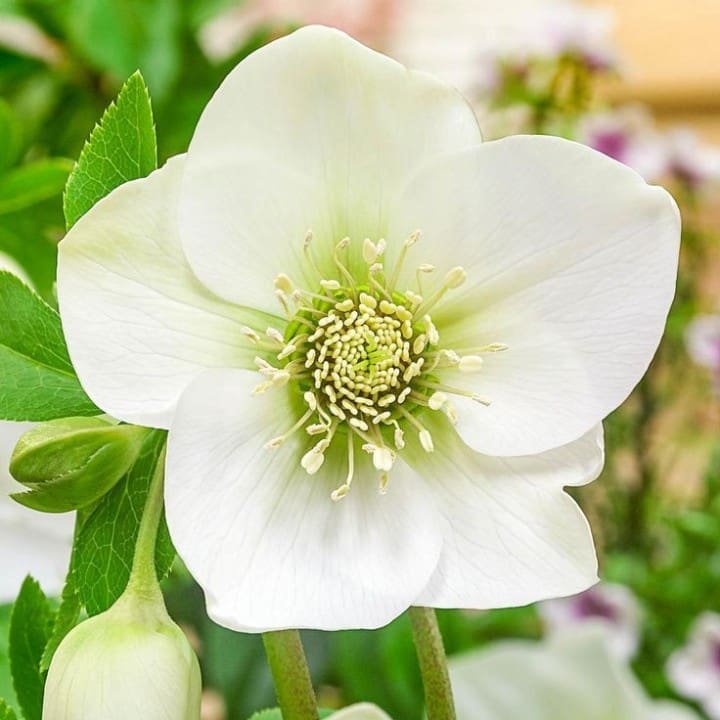
Helleborus niger
Latin name: Helleborus niger
Short name: Hell
Common name: Christmas Rose | Black Hellebore | Bear’s Foot | Melampode
Primary miasm: Syphilitic
Kingdom: Plants
Family: Ranunculaceae
- Symptomatology
- Remedy Information
- Differentiation & Application
Helleborus niger is a perennial herb native to Europe, particularly the Alpine regions. It belongs to the Ranunculaceae family. The plant contains helleborin, a toxic glycoside that exerts a marked depressive effect on the nervous system and heart. Historically, it was used in ancient Greece for its cathartic and emetic properties, especially in mania and melancholy. In homeopathy, it reveals its deepest action on the mind, cerebrospinal system, and serous membranes, especially in conditions of mental dulness, cerebral effusion, and low states of vitality.
Historically used as a purgative and treatment for insanity in Greco-Roman medicine; no longer used due to its toxicity.
Proved by Hahnemann and reported in Materia Medica Pura. Symptoms were also observed from poisonings. Clinical usage became prominent through Hering and others in cases of hydrocephalus and stuporous states.
- Brain – especially cerebrum, meninges, and cerebral ventricles
- Mind and sensorium – dullness, apathy, mental stupor
- Cerebrospinal axis – weakness, tremors, unconscious movements
- Eyes and pupils – visual weakness, slow reaction to light
- Urinary system – suppression, involuntary dribbling
- Skin – eruptions, chill, coldness
- Gastrointestinal tract – nausea, slow digestion, eructation
- Bending head backward (in hydrocephalus)
- Covering up warmly
- Quiet
- After sleep (briefly)
- Lying on abdomen (in brain complaints)
- Mental exertion
- Sudden noise or light
- Suppressed eruptions or discharges
- Cold air or uncovering
- 4–8 a.m. aggravation
- Dentition or brain trauma in children
- Suppressed menses
- Apis mellifica – Cerebral effusion with more excitement, thirstlessness, and red cheeks
- Belladonna – Violent congestion with active delirium, not torpor
- Opium – Profound stupor with warm body, stertorous breathing, and no response
- Zincum metallicum – Twitching, automatic movements, but with more restlessness and fidgety feet
- Baryta carbonica – Imbecility or arrested development with enlarged glands
- Cicuta virosa – More violent spasms, opisthotonos, and cyanosis
- Complementary: Zincum, Sulphur
- Antidotes: Camphora, Coffea
- Follows well: Belladonna in meningitis
- Precedes well: Baryta carb in mental deficiency
- Inimical: Opium (similar action but differing picture)
Helleborus niger expresses a state of withdrawal, collapse, and inner darkness. The mental life is suspended—not agitated but silenced. It is a remedy of suppressed vitality, where the flame of consciousness burns dimly. The eyes are open but the soul is hidden. Ideal in cases of cerebral depression, effusion, and inward suffocation of function, whether from infection, trauma, or miasmatic suppression. The stillness of Helleborus is not peace, but a terrifying void.
- Indispensable in hydrocephalus (especially after Apis or Belladonna)
- Consider in post-encephalitic or meningitic sequelae
- Useful in stupor of typhoid, uremic coma, or puerperal brain syndrome
- Often needed in infants with mental regression or delay after illness
- Keynote: Sopor, twitching, and unconscious moaning without restlessness
Mind
- Stupefaction, unconsciousness
- Answers slowly, or not at all
- Moaning, groaning, involuntary
- Indifference to everything
Head
- Rolling of head
- Cold sweat on forehead
- Fontanelles open and bulging
Eyes
- Pupils dilated, sluggish
- Eyeballs turned upward
- Squinting, staring
Urine
- Retention, suppression
- Involuntary dribbling
Generalities
- Twitching of muscles
- Weakness, prostration
- Better from warmth
- Samuel Hahnemann – Materia Medica Pura: Primary proving symptoms including stupor, coldness, and slow responses
- C. Hering – Guiding Symptoms: Cerebral and hydrocephalic themes elaborated
- J.T. Kent – Lectures on Homoeopathic Materia Medica: Mental and neurological insights
- William Boericke – Pocket Manual: Practical clinical guidance on hydrocephalus and stupor
- John Henry Clarke – Dictionary of Practical Materia Medica: Expanded commentary on suppressed eruptions, low fevers, and urinary complaints
- Allen’s Encyclopaedia: Toxicological confirmations and differential insights
